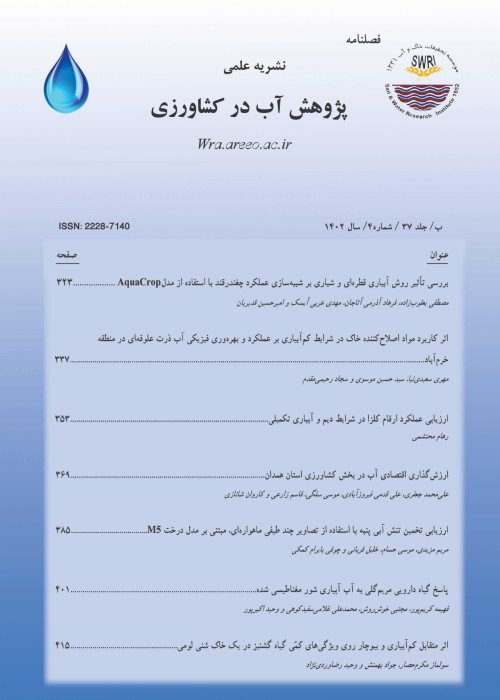Evaluation of Forage Sorghum Yield Quality and Quantity at Different Levels of Salinity and Irrigation Water under Subsurface Drip Irrigation System
Abstract:
Water stress and salinity are among the problems of agricultural production in many parts of the world. In this study, the effect of salinity (2, 5 and 8 dS/m), different irrigation levels (120%, 100%, 75%, and 50% of water requirement) and three harvesting times (cuttings) were investigated on some qualitative and quantitative parameters of sorghum silage in the Sistan region. The study was carried out using a factorial split plot design with 12 treatments and 3 replications. The results showed that increasing salinity and irrigation water depth decreased fresh and dry matter yield. However, no significant difference was observed between 100% and 75% crop water requirement treatments. Also, treatments with 2 and 5 dS/m salinity were not significantly different in feed production. Furthermore, the fresh and dry forage yields were higher in the second cutting than in the first and third harvesting. Decrease in irrigation water and increase in salinity decreased protein but increased carbohydrate and proline. The highest amount of protein (16.79 percent) was obtained in the second harvesting and at the salinity of 2 dS/m, while the highest amount of carbohydrates (10.79 mg/gFW) and proline (0.42 mg/gFW) belonged to the third harvesting with salinity of 8 dS/m. By increasing salinity in irrigation water and with the passage of time during the growing season, soil salinity increased and distribution of salinity in the soil profile was more uniform in the treatments that had no water stress. Thus, according to the results, 25% of the plant water consumption can be saved and irrigation with 75% of water requirement and salinity of 5 dS/m would have no significant effect on the amount of forage produced. The best forage quality for livestock consumption was obtained in the second harvesting. However, this experiment was done in one growing season and in the long time reduction in the amount of water and the use of salt water can cause soil salinization and accumulation of salts in the soil. Therefore, it is recommended that the experiment be repeated in the future, before making a final decision about reducing irrigation water.
Keywords:
Language:
Persian
Published:
Journal of Water Research in Agriculture, Volume:30 Issue: 4, 2017
Pages:
467 to 482
magiran.com/p1656153
دانلود و مطالعه متن این مقاله با یکی از روشهای زیر امکان پذیر است:
اشتراک شخصی
با عضویت و پرداخت آنلاین حق اشتراک یکساله به مبلغ 1,390,000ريال میتوانید 70 عنوان مطلب دانلود کنید!
اشتراک سازمانی
به کتابخانه دانشگاه یا محل کار خود پیشنهاد کنید تا اشتراک سازمانی این پایگاه را برای دسترسی نامحدود همه کاربران به متن مطالب تهیه نمایند!
توجه!
- حق عضویت دریافتی صرف حمایت از نشریات عضو و نگهداری، تکمیل و توسعه مگیران میشود.
- پرداخت حق اشتراک و دانلود مقالات اجازه بازنشر آن در سایر رسانههای چاپی و دیجیتال را به کاربر نمیدهد.
In order to view content subscription is required
Personal subscription
Subscribe magiran.com for 70 € euros via PayPal and download 70 articles during a year.
Organization subscription
Please contact us to subscribe your university or library for unlimited access!


